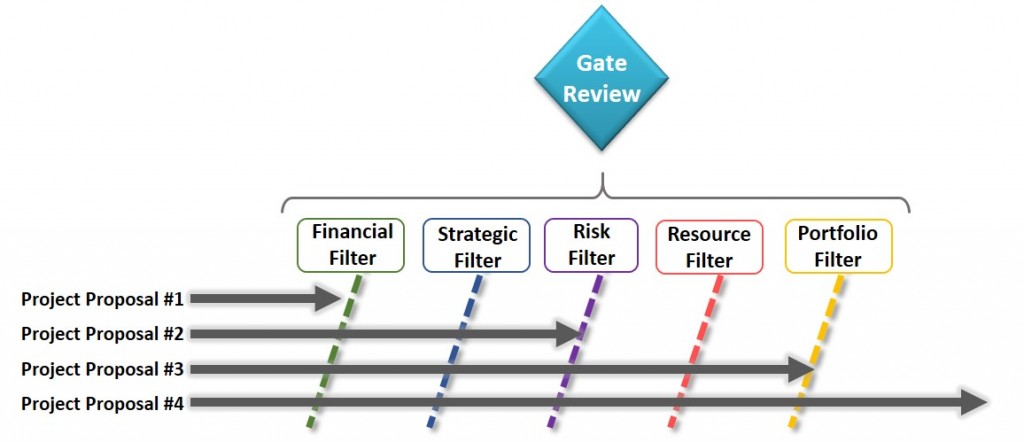Phase-gate reviews improve project selection. If an organization wants a winning portfolio then the governance team must select winning projects. Therefore the project governance board must be able to discriminate between good projects and great projects. The phase-gate process enables the project governance board to review these projects based on preselected strategic criteria at the gate reviews of the decision gate process. At each of those gates, important project information is provided to the project governance board to make a go/no-go decision related to the project. Without this mechanism, unnecessary or poorly planned projects can enter the portfolio and bog down the work load of the organization, hampering the benefits realized from truly important and strategic projects.
The ability to screen out misaligned projects is based on the types of decision making criteria used for gate reviews. Another way to look at the criteria is that they act as gate review filters. For instance, some companies may have no filters and approve every project; another company may only judge projects based on financial contribution and screen out very fewer projects; whereas other companies will makes gate decisions based on financial contribution, investment risk, and resource availability. We can see this by the image below.
Types of Gate Review Filters
There are many types of decision making filters available for companies to use, the key is to apply the filters that match the organization’s current maturity and culture. Let’s take a look at a few gate review filters (not an exhaustive list):
1) Financial filter: this gate criteria requires some sort of financial analysis to determine the profitability (or value) of the project. Applying financial hurdle rates may be one way of screening out lower value projects. Using financial benefit (e.g. net present value) is one approach to rank ordering projects.
2) Strategic filter: most companies implementing PPM recognize the need to evaluate projects in light of strategic goals and objectives. However, if the criteria is not detailed enough, most projects can be shown to align to strategy to a certain extent.
3) Risk filters: risk criteria at gate reviews should really be thought of as investment risk. Detailed project risks may or may not be known, but based on the type of project being proposed and the initial analysis the riskiness (or risk nature) can be understood. Depending on the risk tolerance of the organization, more projects may be screened out based on the riskiness of the project.
4) Resource filters: a more advanced criteria is resource availability or the utilization of key resources who are currently unavailable. Since many organizations do an inadequate job of measuring resource utilization, this filter may not be used as often.
5) Portfolio filter: for simplicity, a portfolio filter takes an aggregate portfolio view when reviewing individual projects. It measures what the impact to the portfolio is rather than only evaluating the individual merits of the project. It also relates to the balance of the portfolio (short-term versus long-term, risky versus safe, good distribution among business units, etc.).
As organizations mature their project selection process, more gate review filters (criteria) should be used to ensure that right projects get included in the portfolio. More criteria often means fewer projects get approved which means that the project pipeline more closely resembles a “funnel” rather than a “tunnel” (see this post for details).
